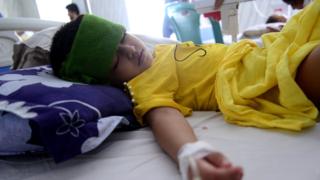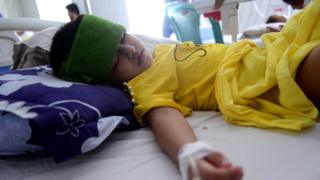Bacterial allies make dengue fever cases dive
Scientists infected mosquitoes with Wolbachia bacteria to make it harder for them to spread disease. …

 Image copyright Getty Images
Image copyright Getty Images Recruiting a bacterial ally that infects mosquitoes has led to huge reductions in cases of dengue fever, trials around the world show.
Wolbachia bacteria make it harder for the insects to spread the virus, rather than kill them off.
Researchers say the findings are a “big deal” with cases falling by more than 70% in field trials.
New ways of controlling dengue are urgently needed as cases have exploded worldwide in the past 50 years.
What is dengue?
Dengue fever is caused by a virus that is spread from person to person by blood-sucking mosquitoes.
The symptoms vary wildly with some people showing no sign of infection, others have bad flu-like symptoms, while some are killed by dengue.
The disease is commonly known as “break-bone fever” because it causes severe pain in muscles and bones.
In the worst cases, people develop “dengue haemorrhagic fever”, which kills 25,000 people a year around the world.
“It doesn’t kill as many as malaria, but it causes an enormous amount of sickness and it is fundamentally a big problem,” said Prof Cameron Simmons, from the World Mosquito Programme.
A growing problem
The World Health Organization says cases have increased “dramatically”.
Rewind the clock to 1970 and only nine countries had faced severe dengue outbreaks. But dengue fever has spread so widely there are now more than 100 countries where the disease is present all the time, known as endemic dengue.
Around half of all people on the planet live in areas where dengue is a problem and there are thought to be 390 million infections each year.
This is in stark contrast to malaria, another mosquito-borne disease, where cases are falling.
Most of the countries affected are in tropical and sub-tropical climates, with 70% of cases in Asia.
“It is a really enormous concern,” Prof Steven Sinkin, from the University of Glasgow, told the BBC.
Where do bacteria come in?
Wolbachia bacteria make it harder for the dengue virus to grow inside the mosquito.
It is thought the bacteria camp out in areas inside mosquitoes that the dengue virus needs to get into and that the bacteria use up resources that the virus needs.
If the dengue virus cannot replicate and increase its numbers in the mosquito then it is much less likely to be transmitted when the insect bites again.
Many species of insects are naturally infected by the bacterium, including the tiny fruit flies dancing around your kitchen.
But the main mosquito that spreads dengue fever – Aedes aegypti – is not normally affected.
So, researchers have been micro-injecting species of Wolbachia into tiny mosquito eggs to see which bacteria can thrive in different climates.
Some are already in large field trials; a team at the University of Glasgow has found a species that can cope in the very warm conditions (high 30Cs) where they would be trialled in Malaysia.
Is this genetic modification?
No, although that approach is also being investigated by scientists.
Wolbachia counts as biological control – using one species to control another.
“It is relatively uncontroversial: it is not infectious to humans and is perfectly safe,” Prof Sinkin said.
Prof Simmons said “enormous efforts” went into building community support before any trials went ahead and that one of the main complaints was a rise in the number of mosquito bites when fresh batches of insects are released.
How good were the results?
There are multiple trials going on around the world – one has published in the journal Current Biology, and scientists are discussing other data at the annual meeting of the American Society of Tropical Medicine and Hygiene.
The evidence shows:
- A 40% reduction overall, but up to 90%, in dengue cases in trials in Kuala Lumpur, Malaysia
- A 76% reduction in dengue cases in trials in Java, Indonesia
- A 70% reduction in dengue cases in trials in Niterói, a city near Rio in Brazil
- Transmission has stopped in far North Queensland, Australia
“Dengue control is extremely challenging, these results are a big deal,” Prof Sinkin, who worked in Kuala Lumpur, told the BBC.
Could this approach stop dengue completely?
“What the mathematical modelling would suggest is, if you take a city and build a great moat around it and stop people moving in and out, then you’d eliminate dengue in that city,” Prof Cameron Simmons told the BBC.
The issue is people move around, so there would be cases when people visited areas where the mosquitoes had not been infected.
But Prof Simmons said: “Fundamentally, we should be able to achieve elimination.”
How long will it last?
Forever.
Wolbachia is a pretty nifty group of bacteria that manipulate the way insects reproduce to ensure they are passed on to the next generation.
In Aedes aegypti the bacteria stops the males reproducing with any female mosquitoes lacking Wolbachia.
However, the Wolbachia-infected females, who pass it on to all their young, can successful mate with any male.
It means that Wolbachia can establish a vice-like grip in a population of mosquitoes.
In the Kuala Lumpur trials, the proportion of mosquitoes affected by Wolbachia exceeded 90%.
Is this expensive or bad for the environment?
The answer is no and no.
Obviously, a lot of research has gone into this approach and that costs money.
However, it is a one-off solution as the Wolbachia are passed on from one generation of mosquitoes to the next.
“It is a very economically attractive approach,” says Prof Sinkin.
This is the opposite of other approaches, such as insecticides or releasing sterile mosquitoes.
Both can shrink the mosquito population, but it will explode again as soon as you stop.
Some areas that have used Wolbachia have been able to stop using insecticide fogging, which is good news for other insect species.
What about other diseases?
The approach appears to work against other related viruses including Zika, chikungunya, and yellow fever.
Dr Luciano Moreira, from the Oswaldo Cruz Foundation in Brazil, said: “Disease surveillance by the Ministry of Health is showing there was 75% less chikungunya in Niteró where we released the mosquitoes, compared with areas where we are not working.”
What do the experts say?
Dr Chandy John, president of the American Society of Tropical Medicine and Hygiene, said: “This is exciting work, carried out in the midst of an explosion in dengue infections that health authorities are finding very difficult to control.
“The combination of advanced science and committed community engagement is impressive – and essential to its success.”
Michael Chew, from the Wellcome medical research charity, said: “The unprecedented rise of dengue worldwide make control methods such as these a vital addition to the tools we currently have to tackle one of the fastest-spreading mosquito-borne viral diseases.”
Follow James on Twitter.

